Skyline University MBA: Managerial Economics Case Study - Spring 2020
VerifiedAdded on 2022/09/09
|16
|1326
|15
Case Study
AI Summary
This case study analyzes the pricing and production decisions of PoolVac, Inc., a company that manufactures and sells automatic pool cleaners. The assignment involves applying managerial economics principles to analyze the firm's cost structure, demand estimation, and profit maximization strategies. The analysis includes regression analysis of average variable cost and demand, determining optimal pricing and output levels, and evaluating the impact of changes in fixed costs and competitor pricing. The student applies concepts like elasticity, marginal revenue, and marginal cost to make informed decisions and recommendations for PoolVac, Inc. The student also examines the effects of income changes and cross-price elasticity on demand. The assignment requires detailed calculations, explanations, and interpretations of the results, including the use of statistical significance to evaluate regression coefficients and the impact of various scenarios on profit and revenue.
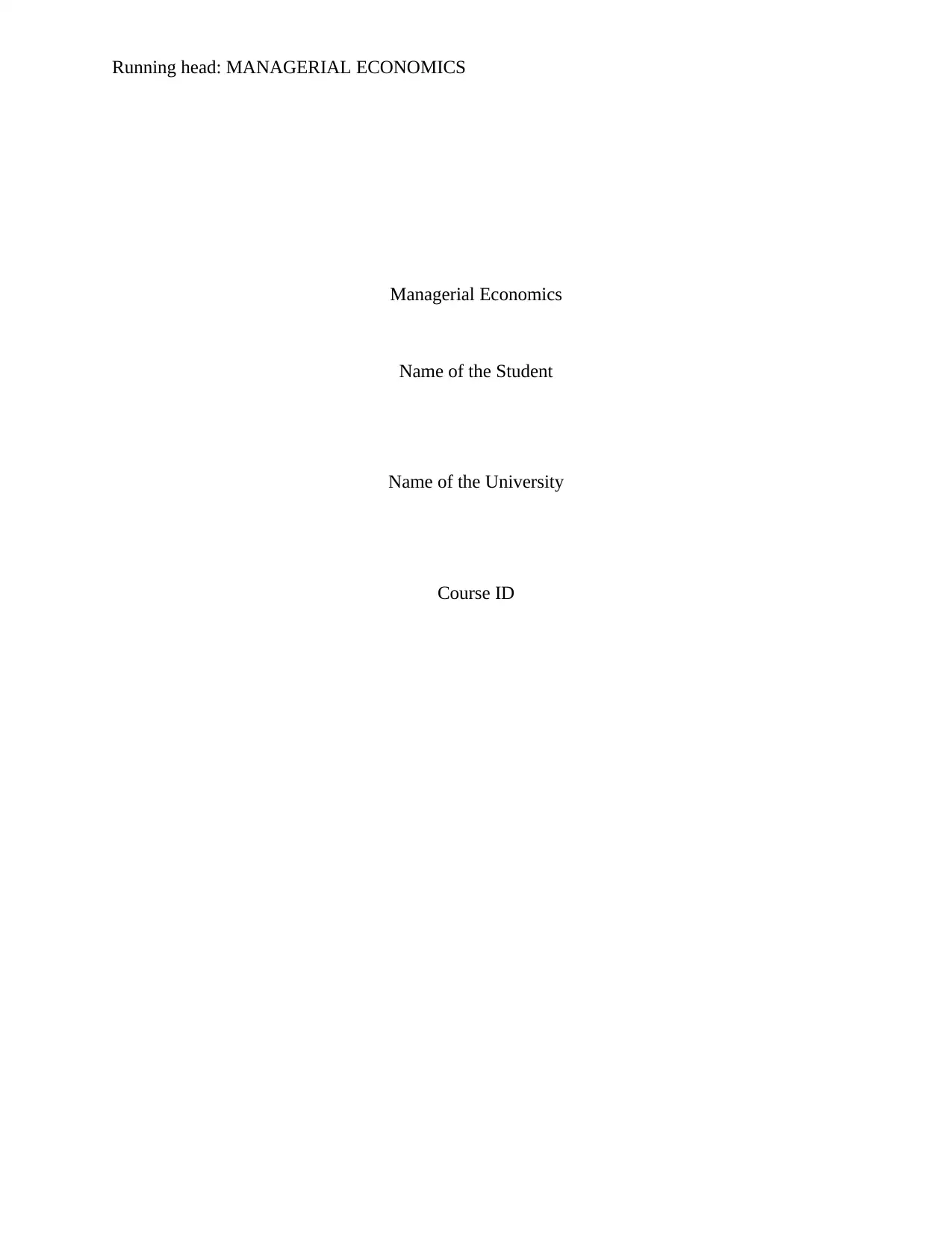
Running head: MANAGERIAL ECONOMICS
Managerial Economics
Name of the Student
Name of the University
Course ID
Managerial Economics
Name of the Student
Name of the University
Course ID
Paraphrase This Document
Need a fresh take? Get an instant paraphrase of this document with our AI Paraphraser
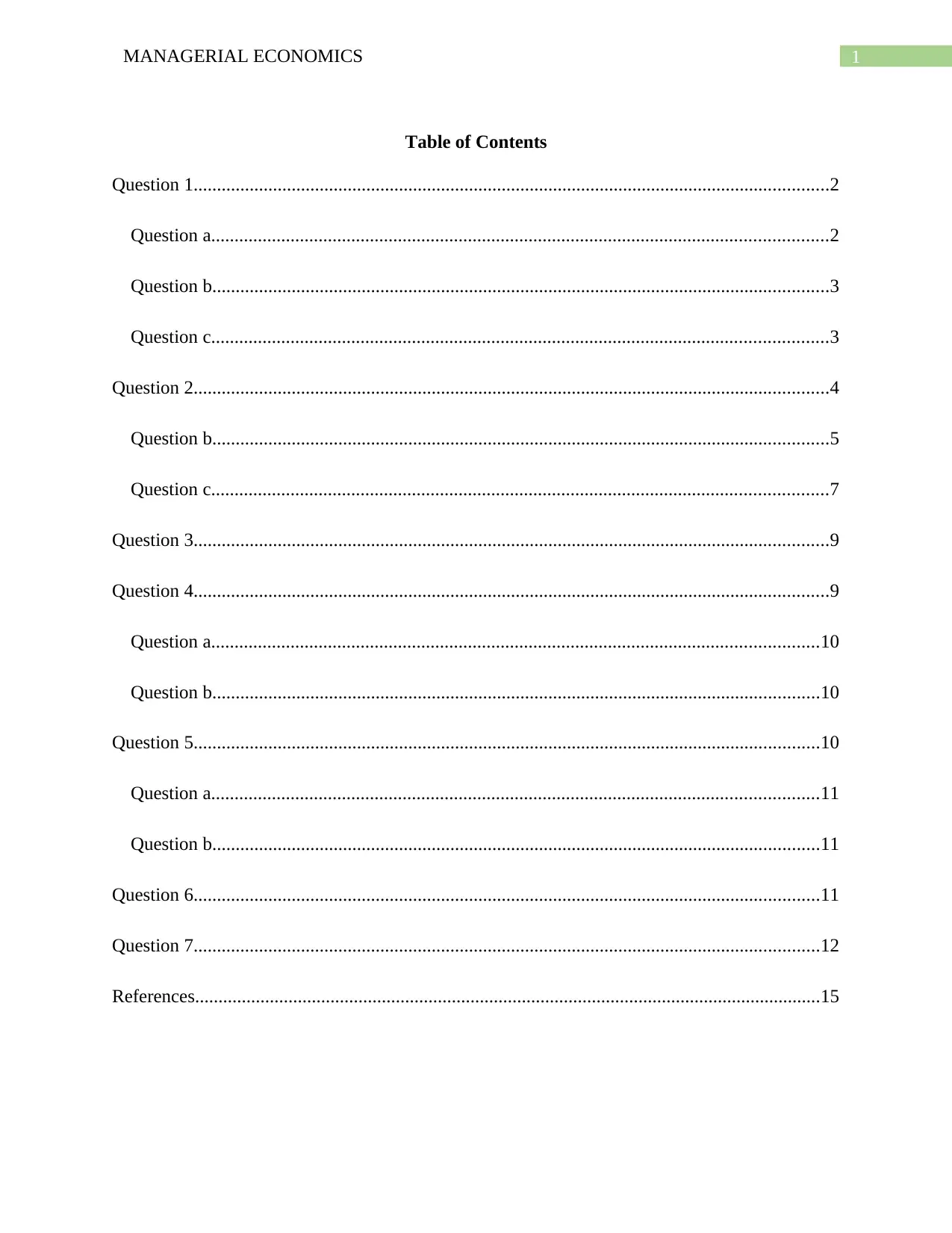
1MANAGERIAL ECONOMICS
Table of Contents
Question 1........................................................................................................................................2
Question a....................................................................................................................................2
Question b....................................................................................................................................3
Question c....................................................................................................................................3
Question 2........................................................................................................................................4
Question b....................................................................................................................................5
Question c....................................................................................................................................7
Question 3........................................................................................................................................9
Question 4........................................................................................................................................9
Question a..................................................................................................................................10
Question b..................................................................................................................................10
Question 5......................................................................................................................................10
Question a..................................................................................................................................11
Question b..................................................................................................................................11
Question 6......................................................................................................................................11
Question 7......................................................................................................................................12
References......................................................................................................................................15
Table of Contents
Question 1........................................................................................................................................2
Question a....................................................................................................................................2
Question b....................................................................................................................................3
Question c....................................................................................................................................3
Question 2........................................................................................................................................4
Question b....................................................................................................................................5
Question c....................................................................................................................................7
Question 3........................................................................................................................................9
Question 4........................................................................................................................................9
Question a..................................................................................................................................10
Question b..................................................................................................................................10
Question 5......................................................................................................................................10
Question a..................................................................................................................................11
Question b..................................................................................................................................11
Question 6......................................................................................................................................11
Question 7......................................................................................................................................12
References......................................................................................................................................15
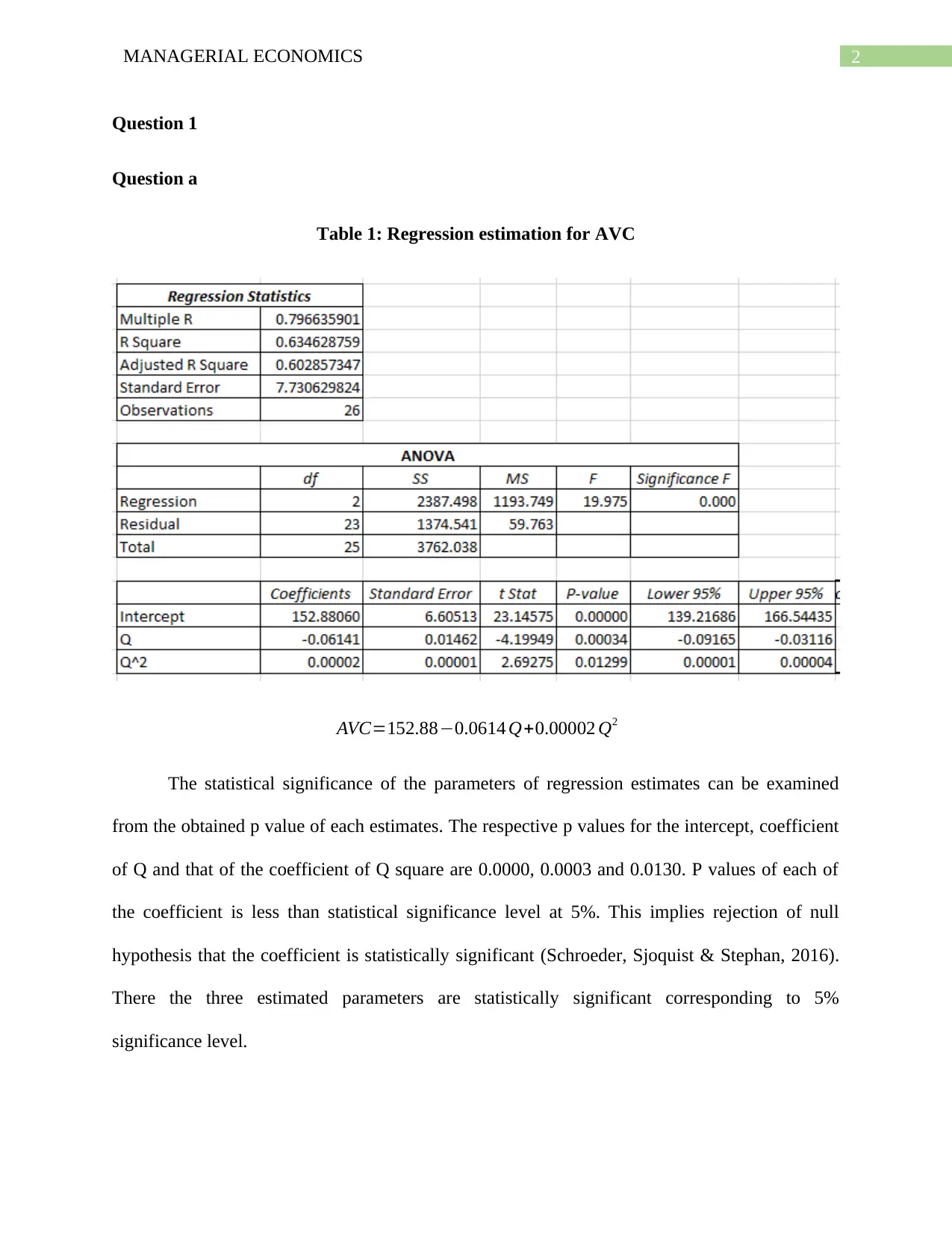
2MANAGERIAL ECONOMICS
Question 1
Question a
Table 1: Regression estimation for AVC
AVC=152.88−0.0614 Q+0.00002 Q2
The statistical significance of the parameters of regression estimates can be examined
from the obtained p value of each estimates. The respective p values for the intercept, coefficient
of Q and that of the coefficient of Q square are 0.0000, 0.0003 and 0.0130. P values of each of
the coefficient is less than statistical significance level at 5%. This implies rejection of null
hypothesis that the coefficient is statistically significant (Schroeder, Sjoquist & Stephan, 2016).
There the three estimated parameters are statistically significant corresponding to 5%
significance level.
Question 1
Question a
Table 1: Regression estimation for AVC
AVC=152.88−0.0614 Q+0.00002 Q2
The statistical significance of the parameters of regression estimates can be examined
from the obtained p value of each estimates. The respective p values for the intercept, coefficient
of Q and that of the coefficient of Q square are 0.0000, 0.0003 and 0.0130. P values of each of
the coefficient is less than statistical significance level at 5%. This implies rejection of null
hypothesis that the coefficient is statistically significant (Schroeder, Sjoquist & Stephan, 2016).
There the three estimated parameters are statistically significant corresponding to 5%
significance level.
⊘ This is a preview!⊘
Do you want full access?
Subscribe today to unlock all pages.

Trusted by 1+ million students worldwide
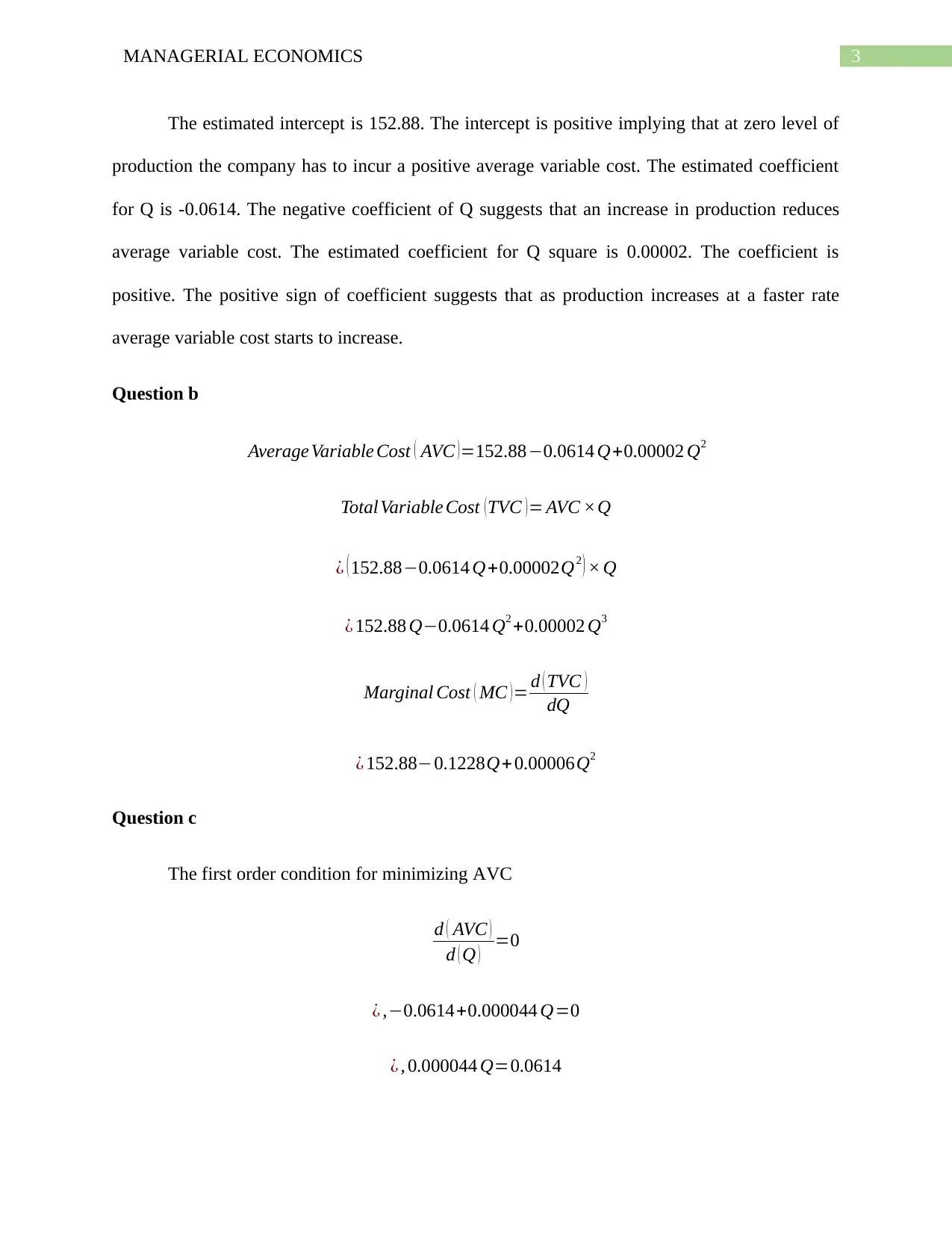
3MANAGERIAL ECONOMICS
The estimated intercept is 152.88. The intercept is positive implying that at zero level of
production the company has to incur a positive average variable cost. The estimated coefficient
for Q is -0.0614. The negative coefficient of Q suggests that an increase in production reduces
average variable cost. The estimated coefficient for Q square is 0.00002. The coefficient is
positive. The positive sign of coefficient suggests that as production increases at a faster rate
average variable cost starts to increase.
Question b
Average Variable Cost ( AVC )=152.88−0.0614 Q+0.00002 Q2
Total Variable Cost (TVC )= AVC ×Q
¿ ( 152.88−0.0614 Q+0.00002Q2 ) × Q
¿ 152.88 Q−0.0614 Q2 +0.00002 Q3
Marginal Cost ( MC )= d ( TVC )
dQ
¿ 152.88−0.1228Q+ 0.00006Q2
Question c
The first order condition for minimizing AVC
d ( AVC )
d ( Q ) =0
¿ ,−0.0614+0.000044 Q=0
¿ , 0.000044 Q=0.0614
The estimated intercept is 152.88. The intercept is positive implying that at zero level of
production the company has to incur a positive average variable cost. The estimated coefficient
for Q is -0.0614. The negative coefficient of Q suggests that an increase in production reduces
average variable cost. The estimated coefficient for Q square is 0.00002. The coefficient is
positive. The positive sign of coefficient suggests that as production increases at a faster rate
average variable cost starts to increase.
Question b
Average Variable Cost ( AVC )=152.88−0.0614 Q+0.00002 Q2
Total Variable Cost (TVC )= AVC ×Q
¿ ( 152.88−0.0614 Q+0.00002Q2 ) × Q
¿ 152.88 Q−0.0614 Q2 +0.00002 Q3
Marginal Cost ( MC )= d ( TVC )
dQ
¿ 152.88−0.1228Q+ 0.00006Q2
Question c
The first order condition for minimizing AVC
d ( AVC )
d ( Q ) =0
¿ ,−0.0614+0.000044 Q=0
¿ , 0.000044 Q=0.0614
Paraphrase This Document
Need a fresh take? Get an instant paraphrase of this document with our AI Paraphraser
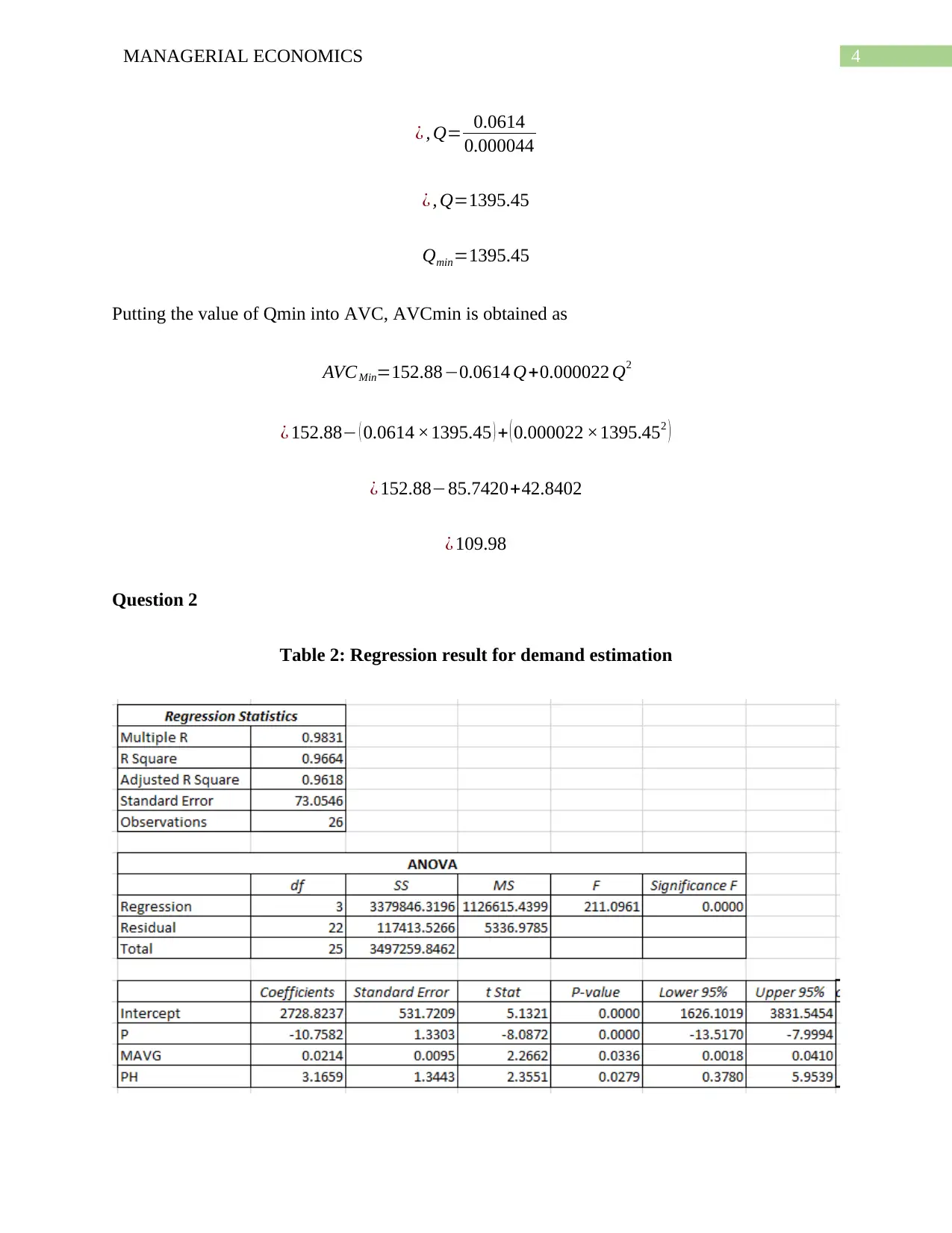
4MANAGERIAL ECONOMICS
¿ , Q= 0.0614
0.000044
¿ , Q=1395.45
Qmin=1395.45
Putting the value of Qmin into AVC, AVCmin is obtained as
AVCMin=152.88−0.0614 Q+0.000022 Q2
¿ 152.88− ( 0.0614 ×1395.45 ) + ( 0.000022 ×1395.452 )
¿ 152.88−85.7420+42.8402
¿ 109.98
Question 2
Table 2: Regression result for demand estimation
¿ , Q= 0.0614
0.000044
¿ , Q=1395.45
Qmin=1395.45
Putting the value of Qmin into AVC, AVCmin is obtained as
AVCMin=152.88−0.0614 Q+0.000022 Q2
¿ 152.88− ( 0.0614 ×1395.45 ) + ( 0.000022 ×1395.452 )
¿ 152.88−85.7420+42.8402
¿ 109.98
Question 2
Table 2: Regression result for demand estimation
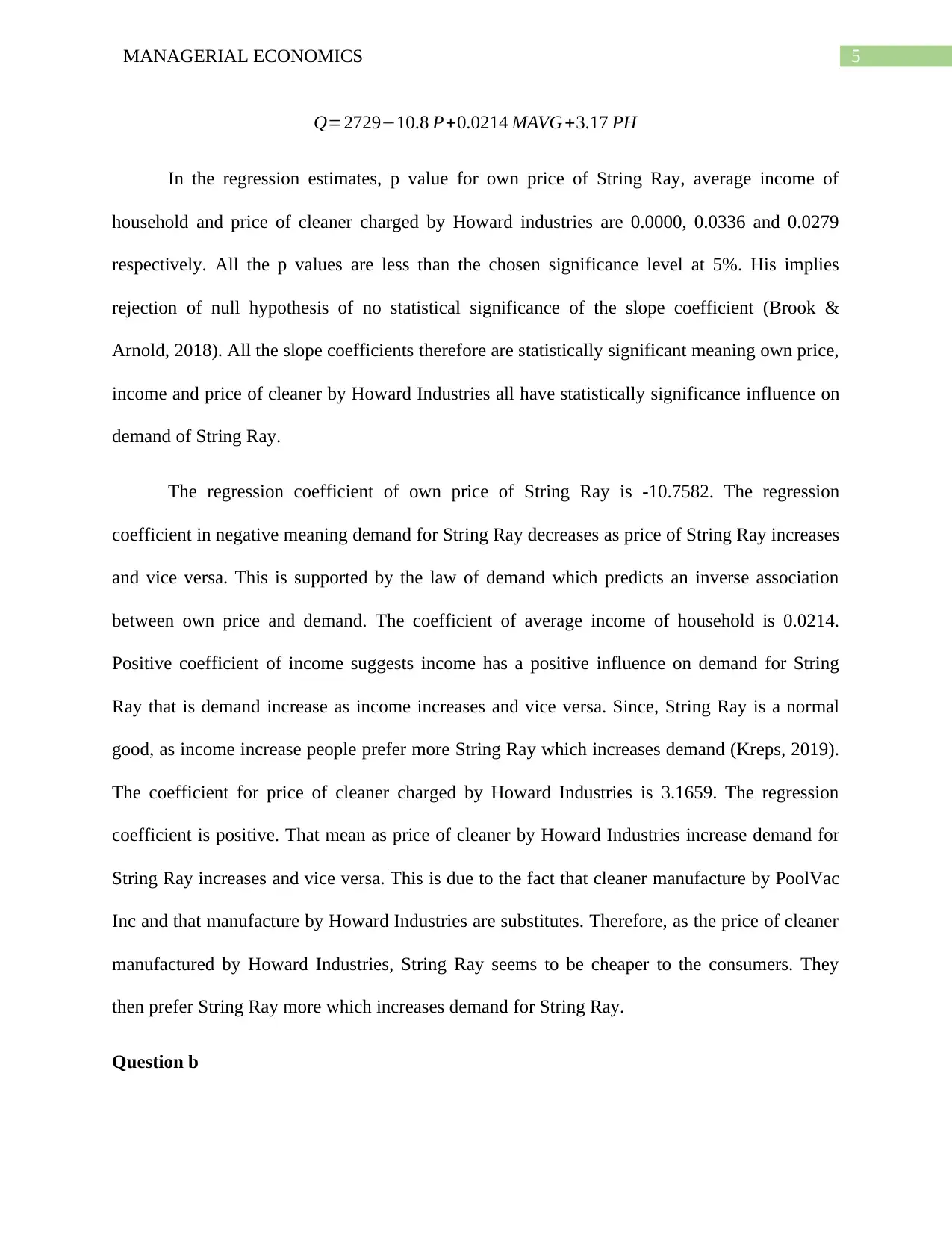
5MANAGERIAL ECONOMICS
Q=2729−10.8 P+0.0214 MAVG +3.17 PH
In the regression estimates, p value for own price of String Ray, average income of
household and price of cleaner charged by Howard industries are 0.0000, 0.0336 and 0.0279
respectively. All the p values are less than the chosen significance level at 5%. His implies
rejection of null hypothesis of no statistical significance of the slope coefficient (Brook &
Arnold, 2018). All the slope coefficients therefore are statistically significant meaning own price,
income and price of cleaner by Howard Industries all have statistically significance influence on
demand of String Ray.
The regression coefficient of own price of String Ray is -10.7582. The regression
coefficient in negative meaning demand for String Ray decreases as price of String Ray increases
and vice versa. This is supported by the law of demand which predicts an inverse association
between own price and demand. The coefficient of average income of household is 0.0214.
Positive coefficient of income suggests income has a positive influence on demand for String
Ray that is demand increase as income increases and vice versa. Since, String Ray is a normal
good, as income increase people prefer more String Ray which increases demand (Kreps, 2019).
The coefficient for price of cleaner charged by Howard Industries is 3.1659. The regression
coefficient is positive. That mean as price of cleaner by Howard Industries increase demand for
String Ray increases and vice versa. This is due to the fact that cleaner manufacture by PoolVac
Inc and that manufacture by Howard Industries are substitutes. Therefore, as the price of cleaner
manufactured by Howard Industries, String Ray seems to be cheaper to the consumers. They
then prefer String Ray more which increases demand for String Ray.
Question b
Q=2729−10.8 P+0.0214 MAVG +3.17 PH
In the regression estimates, p value for own price of String Ray, average income of
household and price of cleaner charged by Howard industries are 0.0000, 0.0336 and 0.0279
respectively. All the p values are less than the chosen significance level at 5%. His implies
rejection of null hypothesis of no statistical significance of the slope coefficient (Brook &
Arnold, 2018). All the slope coefficients therefore are statistically significant meaning own price,
income and price of cleaner by Howard Industries all have statistically significance influence on
demand of String Ray.
The regression coefficient of own price of String Ray is -10.7582. The regression
coefficient in negative meaning demand for String Ray decreases as price of String Ray increases
and vice versa. This is supported by the law of demand which predicts an inverse association
between own price and demand. The coefficient of average income of household is 0.0214.
Positive coefficient of income suggests income has a positive influence on demand for String
Ray that is demand increase as income increases and vice versa. Since, String Ray is a normal
good, as income increase people prefer more String Ray which increases demand (Kreps, 2019).
The coefficient for price of cleaner charged by Howard Industries is 3.1659. The regression
coefficient is positive. That mean as price of cleaner by Howard Industries increase demand for
String Ray increases and vice versa. This is due to the fact that cleaner manufacture by PoolVac
Inc and that manufacture by Howard Industries are substitutes. Therefore, as the price of cleaner
manufactured by Howard Industries, String Ray seems to be cheaper to the consumers. They
then prefer String Ray more which increases demand for String Ray.
Question b
⊘ This is a preview!⊘
Do you want full access?
Subscribe today to unlock all pages.

Trusted by 1+ million students worldwide
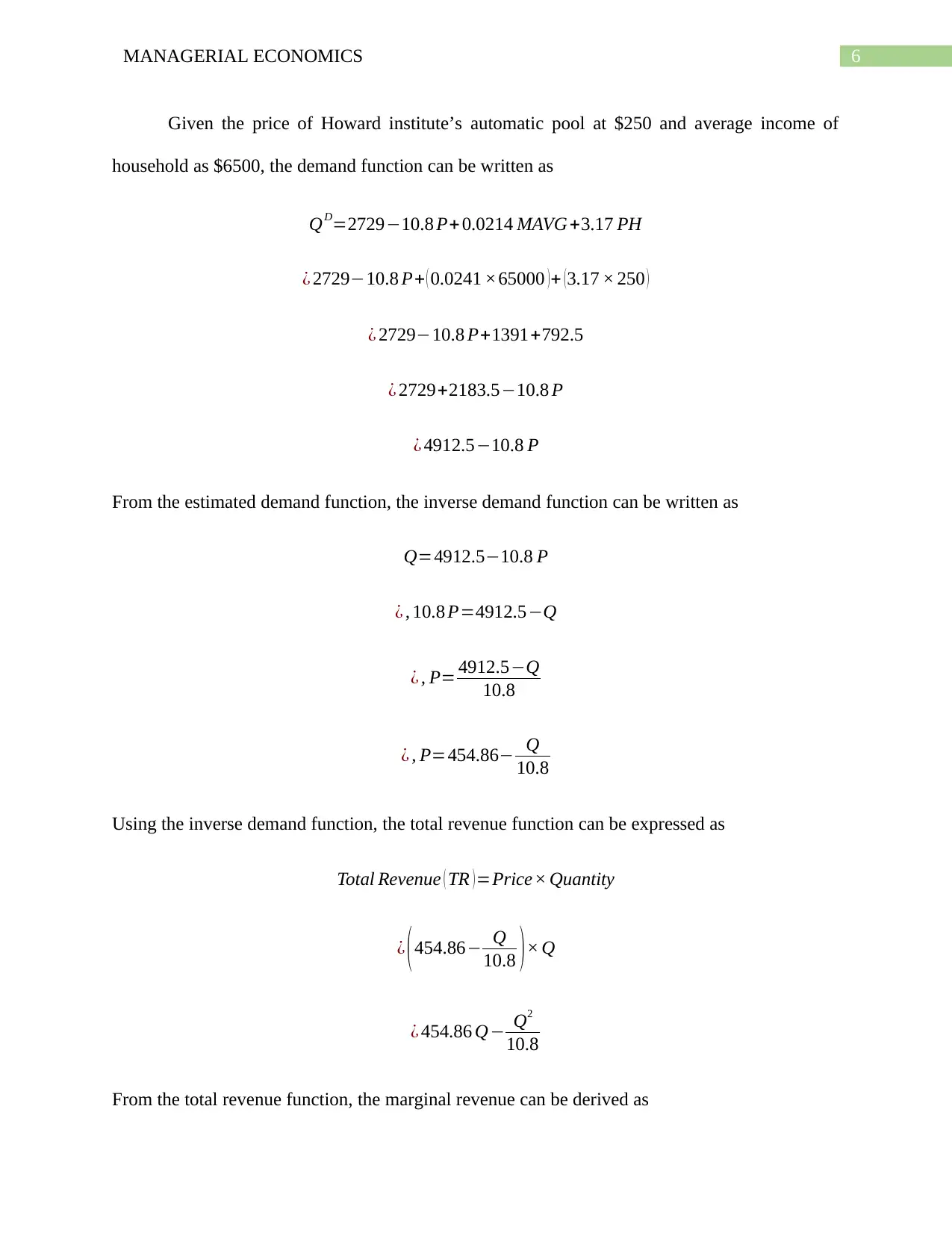
6MANAGERIAL ECONOMICS
Given the price of Howard institute’s automatic pool at $250 and average income of
household as $6500, the demand function can be written as
QD=2729−10.8 P+ 0.0214 MAVG +3.17 PH
¿ 2729−10.8 P+ ( 0.0241 ×65000 )+ (3.17 × 250 )
¿ 2729−10.8 P+1391+792.5
¿ 2729+2183.5−10.8 P
¿ 4912.5−10.8 P
From the estimated demand function, the inverse demand function can be written as
Q=4912.5−10.8 P
¿ , 10.8 P=4912.5−Q
¿ , P= 4912.5−Q
10.8
¿ , P=454.86− Q
10.8
Using the inverse demand function, the total revenue function can be expressed as
Total Revenue ( TR )=Price× Quantity
¿ (454.86− Q
10.8 )× Q
¿ 454.86 Q− Q2
10.8
From the total revenue function, the marginal revenue can be derived as
Given the price of Howard institute’s automatic pool at $250 and average income of
household as $6500, the demand function can be written as
QD=2729−10.8 P+ 0.0214 MAVG +3.17 PH
¿ 2729−10.8 P+ ( 0.0241 ×65000 )+ (3.17 × 250 )
¿ 2729−10.8 P+1391+792.5
¿ 2729+2183.5−10.8 P
¿ 4912.5−10.8 P
From the estimated demand function, the inverse demand function can be written as
Q=4912.5−10.8 P
¿ , 10.8 P=4912.5−Q
¿ , P= 4912.5−Q
10.8
¿ , P=454.86− Q
10.8
Using the inverse demand function, the total revenue function can be expressed as
Total Revenue ( TR )=Price× Quantity
¿ (454.86− Q
10.8 )× Q
¿ 454.86 Q− Q2
10.8
From the total revenue function, the marginal revenue can be derived as
Paraphrase This Document
Need a fresh take? Get an instant paraphrase of this document with our AI Paraphraser
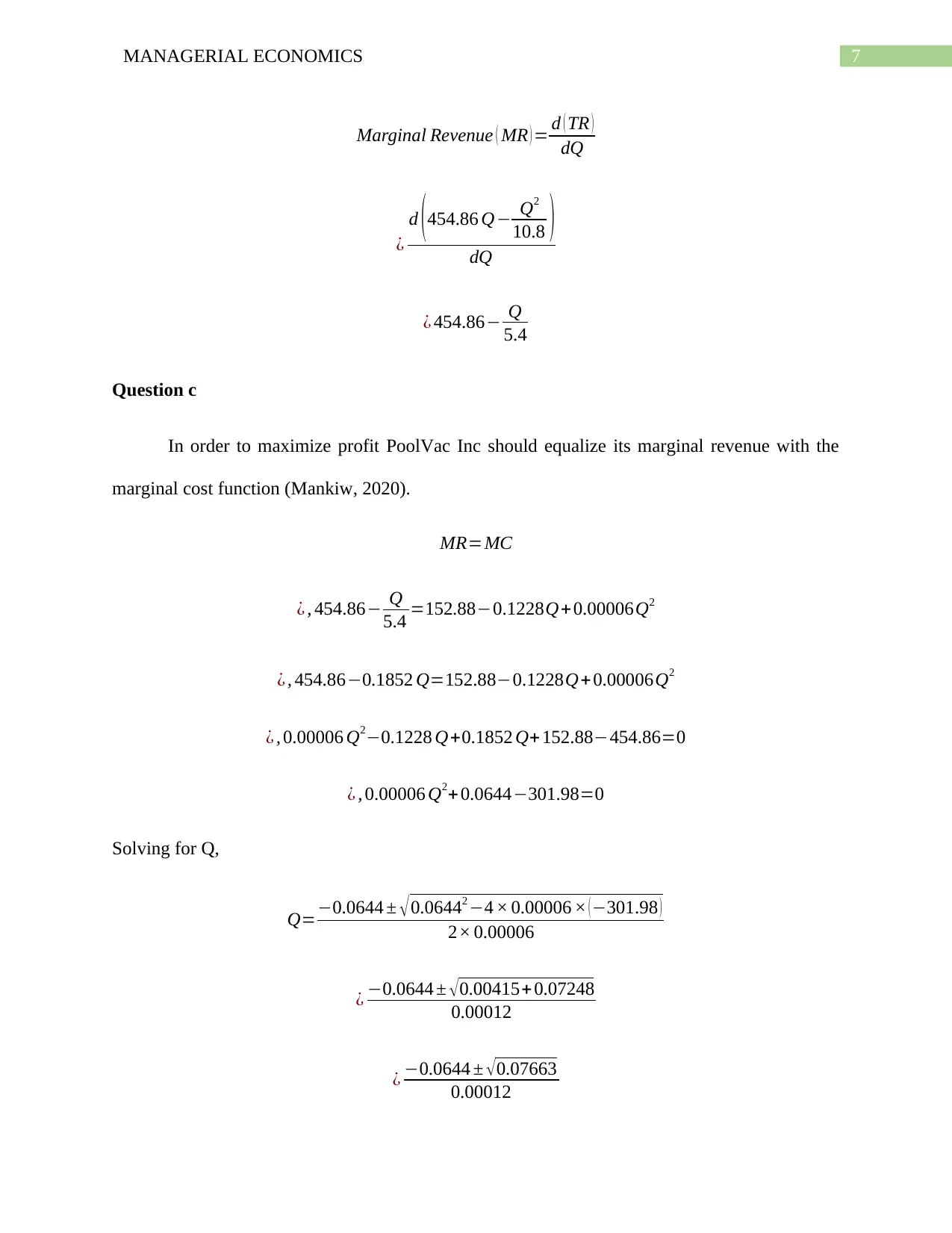
7MANAGERIAL ECONOMICS
Marginal Revenue ( MR ) = d ( TR )
dQ
¿
d (454.86 Q− Q2
10.8 )
dQ
¿ 454.86− Q
5.4
Question c
In order to maximize profit PoolVac Inc should equalize its marginal revenue with the
marginal cost function (Mankiw, 2020).
MR=MC
¿ , 454.86− Q
5.4 =152.88−0.1228Q+0.00006Q2
¿ , 454.86−0.1852 Q=152.88−0.1228Q+0.00006Q2
¿ , 0.00006 Q2−0.1228 Q+0.1852 Q+152.88−454.86=0
¿ , 0.00006 Q2+ 0.0644−301.98=0
Solving for Q,
Q=−0.0644 ± √ 0.06442 −4 × 0.00006 × ( −301.98 )
2× 0.00006
¿ −0.0644 ± √0.00415+ 0.07248
0.00012
¿ −0.0644 ± √0.07663
0.00012
Marginal Revenue ( MR ) = d ( TR )
dQ
¿
d (454.86 Q− Q2
10.8 )
dQ
¿ 454.86− Q
5.4
Question c
In order to maximize profit PoolVac Inc should equalize its marginal revenue with the
marginal cost function (Mankiw, 2020).
MR=MC
¿ , 454.86− Q
5.4 =152.88−0.1228Q+0.00006Q2
¿ , 454.86−0.1852 Q=152.88−0.1228Q+0.00006Q2
¿ , 0.00006 Q2−0.1228 Q+0.1852 Q+152.88−454.86=0
¿ , 0.00006 Q2+ 0.0644−301.98=0
Solving for Q,
Q=−0.0644 ± √ 0.06442 −4 × 0.00006 × ( −301.98 )
2× 0.00006
¿ −0.0644 ± √0.00415+ 0.07248
0.00012
¿ −0.0644 ± √0.07663
0.00012
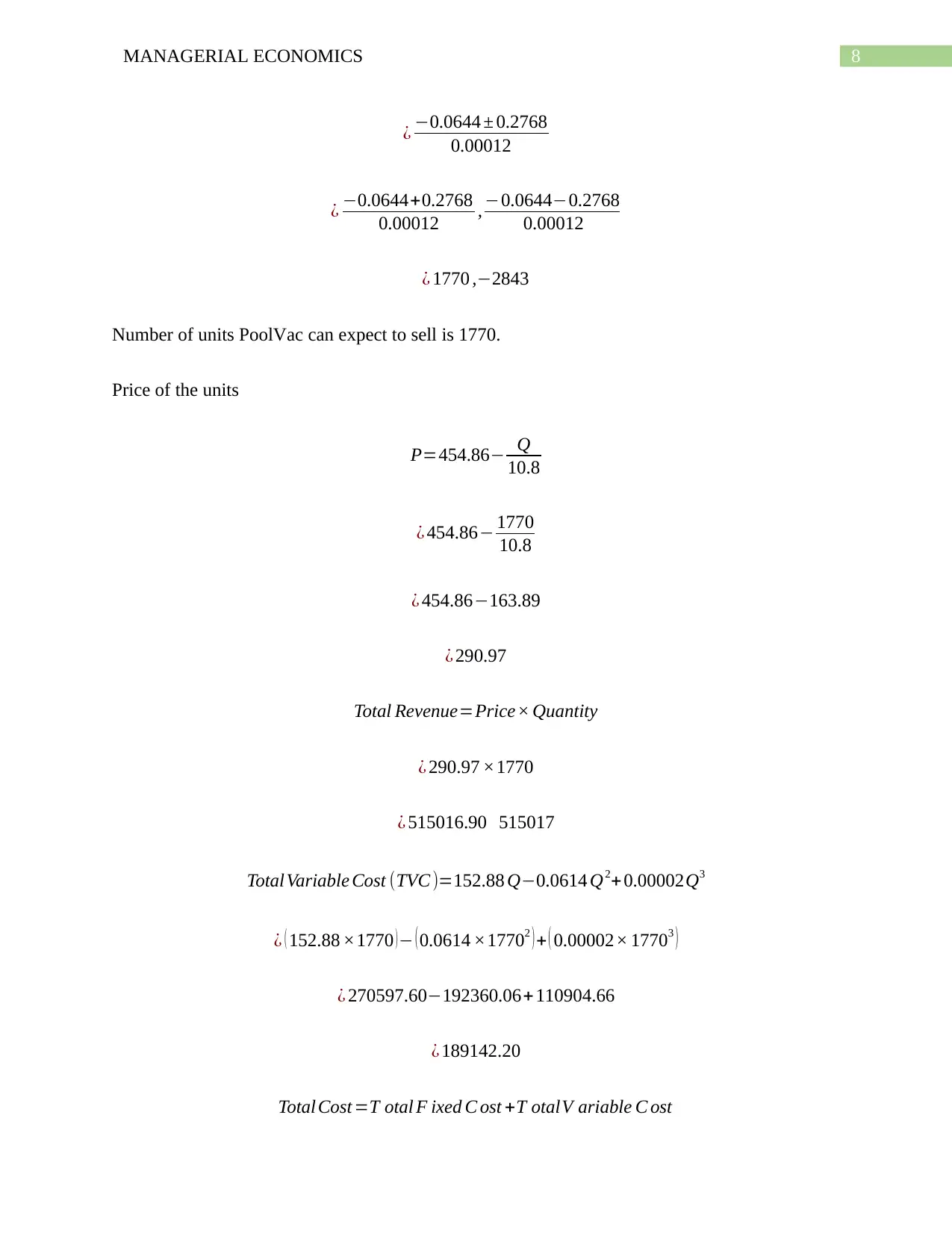
8MANAGERIAL ECONOMICS
¿ −0.0644 ± 0.2768
0.00012
¿ −0.0644+0.2768
0.00012 , −0.0644−0.2768
0.00012
¿ 1770 ,−2843
Number of units PoolVac can expect to sell is 1770.
Price of the units
P=454.86− Q
10.8
¿ 454.86− 1770
10.8
¿ 454.86−163.89
¿ 290.97
Total Revenue=Price× Quantity
¿ 290.97 ×1770
¿ 515016.90 515017
Total Variable Cost (TVC )=152.88 Q−0.0614 Q2+ 0.00002Q3
¿ ( 152.88 ×1770 )− ( 0.0614 ×17702 ) + ( 0.00002× 17703 )
¿ 270597.60−192360.06+ 110904.66
¿ 189142.20
Total Cost =T otal F ixed C ost +T otalV ariable C ost
¿ −0.0644 ± 0.2768
0.00012
¿ −0.0644+0.2768
0.00012 , −0.0644−0.2768
0.00012
¿ 1770 ,−2843
Number of units PoolVac can expect to sell is 1770.
Price of the units
P=454.86− Q
10.8
¿ 454.86− 1770
10.8
¿ 454.86−163.89
¿ 290.97
Total Revenue=Price× Quantity
¿ 290.97 ×1770
¿ 515016.90 515017
Total Variable Cost (TVC )=152.88 Q−0.0614 Q2+ 0.00002Q3
¿ ( 152.88 ×1770 )− ( 0.0614 ×17702 ) + ( 0.00002× 17703 )
¿ 270597.60−192360.06+ 110904.66
¿ 189142.20
Total Cost =T otal F ixed C ost +T otalV ariable C ost
⊘ This is a preview!⊘
Do you want full access?
Subscribe today to unlock all pages.

Trusted by 1+ million students worldwide
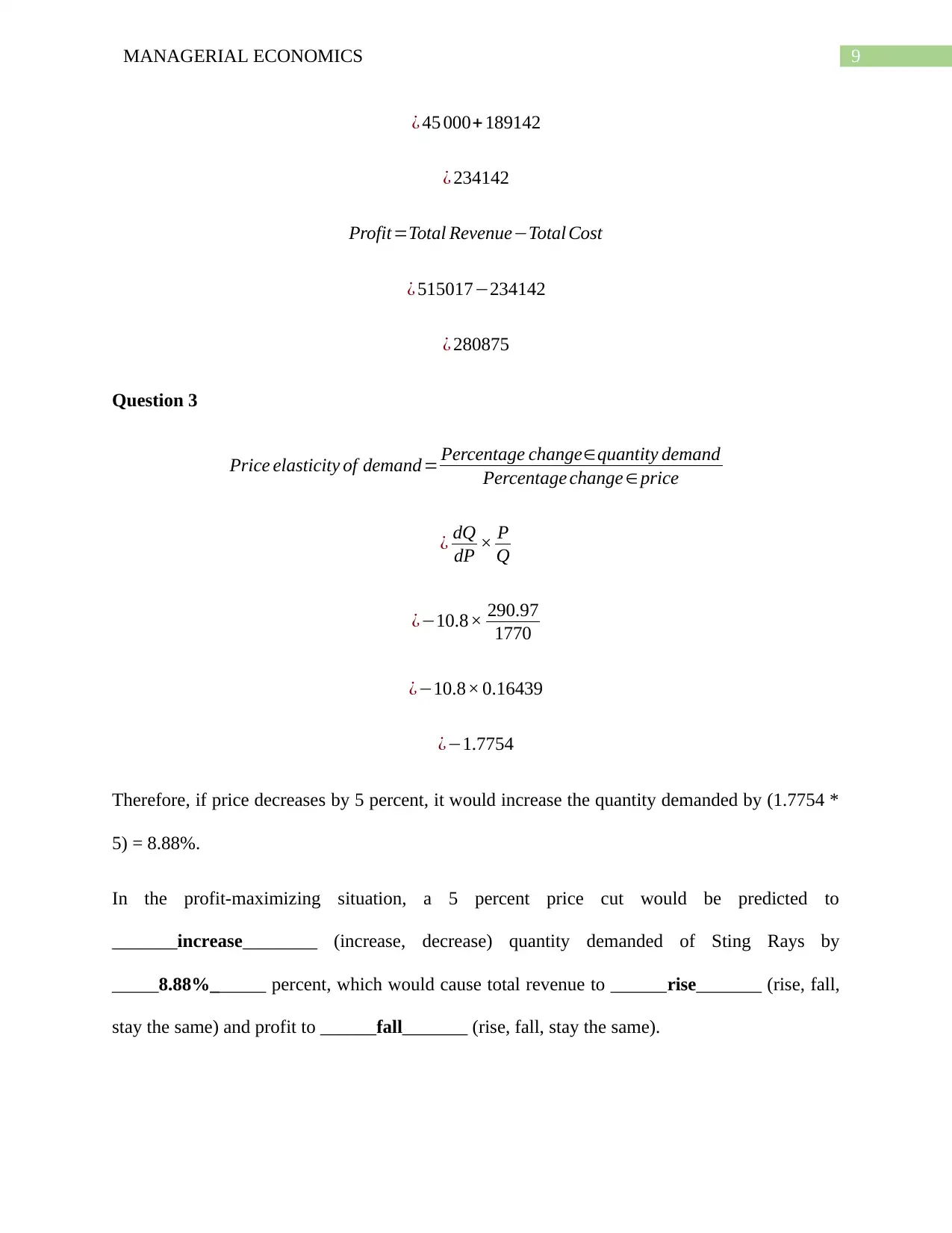
9MANAGERIAL ECONOMICS
¿ 45 000+ 189142
¿ 234142
Profit=Total Revenue−Total Cost
¿ 515017−234142
¿ 280875
Question 3
Price elasticity of demand= Percentage change∈quantity demand
Percentage change ∈ price
¿ dQ
dP × P
Q
¿−10.8× 290.97
1770
¿−10.8× 0.16439
¿−1.7754
Therefore, if price decreases by 5 percent, it would increase the quantity demanded by (1.7754 *
5) = 8.88%.
In the profit-maximizing situation, a 5 percent price cut would be predicted to
_______increase________ (increase, decrease) quantity demanded of Sting Rays by
_____8.88%______ percent, which would cause total revenue to ______rise_______ (rise, fall,
stay the same) and profit to ______fall_______ (rise, fall, stay the same).
¿ 45 000+ 189142
¿ 234142
Profit=Total Revenue−Total Cost
¿ 515017−234142
¿ 280875
Question 3
Price elasticity of demand= Percentage change∈quantity demand
Percentage change ∈ price
¿ dQ
dP × P
Q
¿−10.8× 290.97
1770
¿−10.8× 0.16439
¿−1.7754
Therefore, if price decreases by 5 percent, it would increase the quantity demanded by (1.7754 *
5) = 8.88%.
In the profit-maximizing situation, a 5 percent price cut would be predicted to
_______increase________ (increase, decrease) quantity demanded of Sting Rays by
_____8.88%______ percent, which would cause total revenue to ______rise_______ (rise, fall,
stay the same) and profit to ______fall_______ (rise, fall, stay the same).
Paraphrase This Document
Need a fresh take? Get an instant paraphrase of this document with our AI Paraphraser
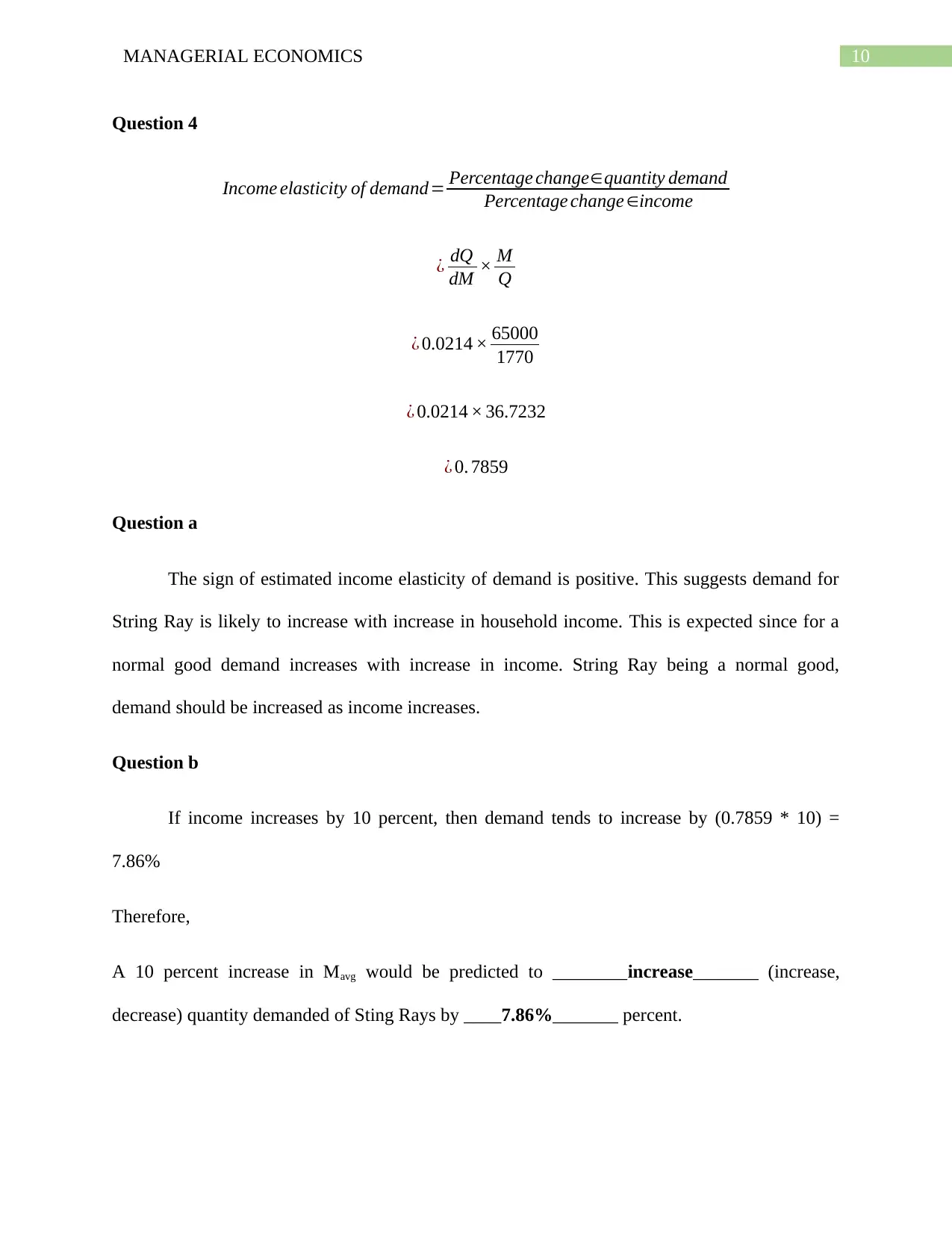
10MANAGERIAL ECONOMICS
Question 4
Income elasticity of demand= Percentage change∈quantity demand
Percentage change ∈income
¿ dQ
dM × M
Q
¿ 0.0214 × 65000
1770
¿ 0.0214 × 36.7232
¿ 0. 7859
Question a
The sign of estimated income elasticity of demand is positive. This suggests demand for
String Ray is likely to increase with increase in household income. This is expected since for a
normal good demand increases with increase in income. String Ray being a normal good,
demand should be increased as income increases.
Question b
If income increases by 10 percent, then demand tends to increase by (0.7859 * 10) =
7.86%
Therefore,
A 10 percent increase in Mavg would be predicted to ________increase_______ (increase,
decrease) quantity demanded of Sting Rays by ____7.86%_______ percent.
Question 4
Income elasticity of demand= Percentage change∈quantity demand
Percentage change ∈income
¿ dQ
dM × M
Q
¿ 0.0214 × 65000
1770
¿ 0.0214 × 36.7232
¿ 0. 7859
Question a
The sign of estimated income elasticity of demand is positive. This suggests demand for
String Ray is likely to increase with increase in household income. This is expected since for a
normal good demand increases with increase in income. String Ray being a normal good,
demand should be increased as income increases.
Question b
If income increases by 10 percent, then demand tends to increase by (0.7859 * 10) =
7.86%
Therefore,
A 10 percent increase in Mavg would be predicted to ________increase_______ (increase,
decrease) quantity demanded of Sting Rays by ____7.86%_______ percent.
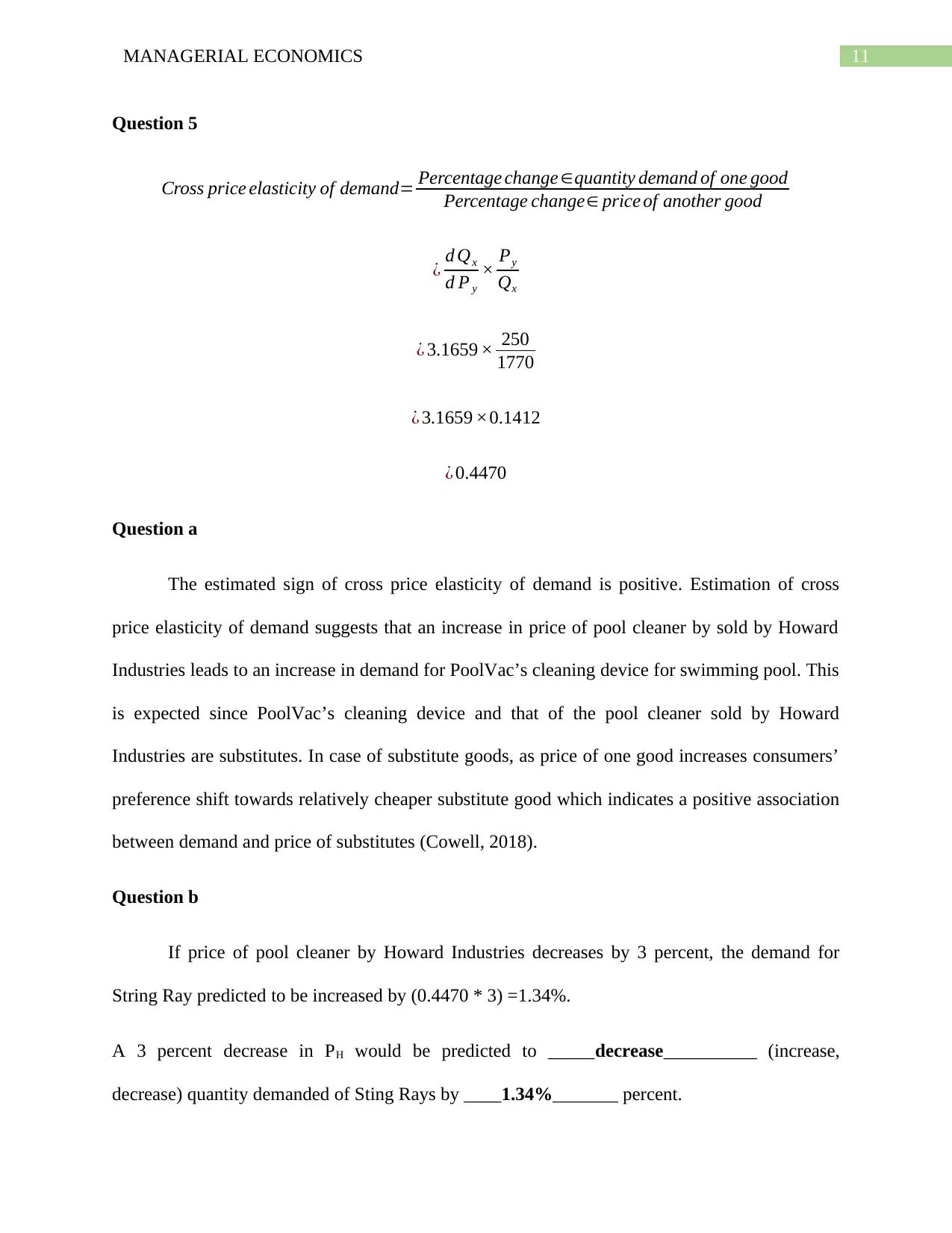
11MANAGERIAL ECONOMICS
Question 5
Cross price elasticity of demand= Percentage change ∈quantity demand of one good
Percentage change∈ price of another good
¿ d Qx
d P y
× Py
Qx
¿ 3.1659 × 250
1770
¿ 3.1659 ×0.1412
¿ 0.4470
Question a
The estimated sign of cross price elasticity of demand is positive. Estimation of cross
price elasticity of demand suggests that an increase in price of pool cleaner by sold by Howard
Industries leads to an increase in demand for PoolVac’s cleaning device for swimming pool. This
is expected since PoolVac’s cleaning device and that of the pool cleaner sold by Howard
Industries are substitutes. In case of substitute goods, as price of one good increases consumers’
preference shift towards relatively cheaper substitute good which indicates a positive association
between demand and price of substitutes (Cowell, 2018).
Question b
If price of pool cleaner by Howard Industries decreases by 3 percent, the demand for
String Ray predicted to be increased by (0.4470 * 3) =1.34%.
A 3 percent decrease in PH would be predicted to _____decrease__________ (increase,
decrease) quantity demanded of Sting Rays by ____1.34%_______ percent.
Question 5
Cross price elasticity of demand= Percentage change ∈quantity demand of one good
Percentage change∈ price of another good
¿ d Qx
d P y
× Py
Qx
¿ 3.1659 × 250
1770
¿ 3.1659 ×0.1412
¿ 0.4470
Question a
The estimated sign of cross price elasticity of demand is positive. Estimation of cross
price elasticity of demand suggests that an increase in price of pool cleaner by sold by Howard
Industries leads to an increase in demand for PoolVac’s cleaning device for swimming pool. This
is expected since PoolVac’s cleaning device and that of the pool cleaner sold by Howard
Industries are substitutes. In case of substitute goods, as price of one good increases consumers’
preference shift towards relatively cheaper substitute good which indicates a positive association
between demand and price of substitutes (Cowell, 2018).
Question b
If price of pool cleaner by Howard Industries decreases by 3 percent, the demand for
String Ray predicted to be increased by (0.4470 * 3) =1.34%.
A 3 percent decrease in PH would be predicted to _____decrease__________ (increase,
decrease) quantity demanded of Sting Rays by ____1.34%_______ percent.
⊘ This is a preview!⊘
Do you want full access?
Subscribe today to unlock all pages.

Trusted by 1+ million students worldwide
1 out of 16
Related Documents
Your All-in-One AI-Powered Toolkit for Academic Success.
+13062052269
info@desklib.com
Available 24*7 on WhatsApp / Email
![[object Object]](/_next/static/media/star-bottom.7253800d.svg)
Unlock your academic potential
Copyright © 2020–2025 A2Z Services. All Rights Reserved. Developed and managed by ZUCOL.




